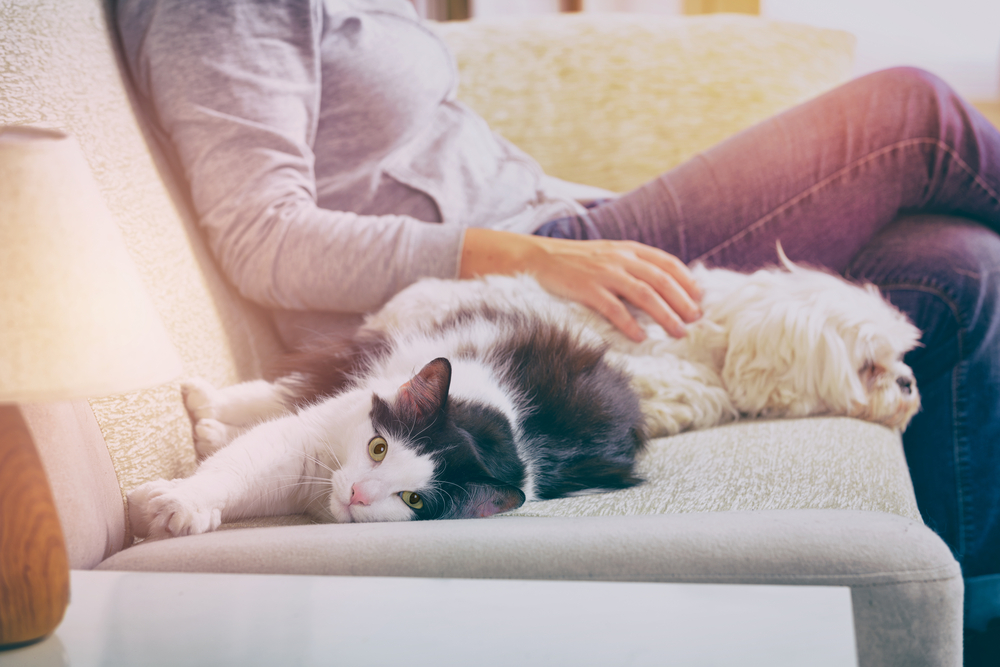It’s not only people who suffer from stress; our pets most certainly do, too. The question is, could you unknowingly be the cause of some of your pet’s anxiety?
Everyday noises and events that humans take for granted, for instance, can cause pets to be fearful and anxious. And because pets, like people, react differently to different triggers, knowing your pet’s personality can help you understand what they may find upsetting and how to best remedy such situations.
Key Stress Triggers for Pets
Anyone who lives with teenagers will understand the ear-splitting decibels at which they like to play music. Cats and dogs don’t enjoy this audio intrusion!
The same can be said for playing the TV at full volume. Ensure that pet beds are not placed near music speakers and sound bars.
One-off events such as loud parties can cause pets to hide. In extreme circumstances, they may even attempt to run away.
We all know about the dislike and fear that many dogs and cats have for vacuum cleaners. In part, that’s related to their highly sensitive hearing. Other noises around the house caused by renovations are stress triggers, too, particularly hammering and drilling.
Sounds such as the garbage truck on pickup day, gardeners blowing leaves, and even construction in the neighborhood can make pets fearful. Even something as innocuous as replacing that tatty old couch with a brand-new one can be a cause of consternation for your pooch or your cat. Suddenly, something smells different right in the middle of their comfy home environment.
Cats in particular are often unhappy if their litter box is suddenly placed in a different part of the home, particularly if it is placed in a high-traffic area or not easily accessed area.
Speaking of litter boxes, many cats are not receptive to a sudden change to the type or scent of litter in their box. If there is a good reason to make a change, make it a slow transition over a period of a week to 10 days.
Pets are perceptive when it comes to human emotions and can react to changes such as the arrival of a new baby. Often pets are sidelined when a baby arrives, so it’s no surprise that they experience stress and anxiety. It’s important to ensure that fur kids get attention and time too during this period of transition. Pairing treats, toys, and attention with the presence of a new human family member is a great way to start off a happy and long-lasting pet-child (or any other) relationship.
Similarly, pets don’t enjoy having house guests “invade” their home, especially if the guests arrive with their own dog or cat. A visiting pet can stress your own pets if they have not been properly introduced. And cats in particular don’t like incessantly barking dogs!
Clues That Your Pet Might Be Stressed
- Excessive barking
- Pacing
- Breaking housetraining
- Growling or snarling from a normally affectionate dog
- Snapping and even biting family members
- Unusual vomiting, diarrhea, appetite loss, or skin allergies
- Excessive grooming and even pulling out clumps of fur
- Destructive behavior such as chewing furniture and other items in the home
- Getting into trash cans
- If your cat is normally content on the couch but suddenly nowhere to be found, this should be cause for concern.
Possible Fixes
Play with your pet before you go to work in the morning. For a dog, a nice walk is a great start to the day. For a cat, consider a brief game with a wand toy.
Both dogs and cats love comfort toys. Dogs will often carry them around before settling down to “nanny” them. Cats will appreciate anything with catnip.
Move a cat tree near a window so your cat can watch the activity in the garden or on the street (Move it from there if construction is going on outside or nearby.)
Puzzle toys filled with treats or even used as a food bowl are a great way to keep pets active and engaged while they are home alone.
Calming shirts for dogs or cats might help reduce anxiety levels for some pets.
Calming pheromone sprays have a soothing effect. Consider using them in conjunction with a garment or spray them around the home.
Sometimes the level of stress is gradual, so be vigilant in paying attention to your pet’s response to the environment.
Medical changes can also result in behavioral changes in your pet. If you notice a change in your pet’s behavior, an appointment with the veterinarian, especially one who is Fear Free certified, is always a good first step.
This article was reviewed/edited by board-certified veterinary behaviorist Dr. Kenneth Martin and/or veterinary technician specialist in behavior Debbie Martin, LVT.








